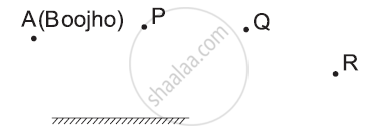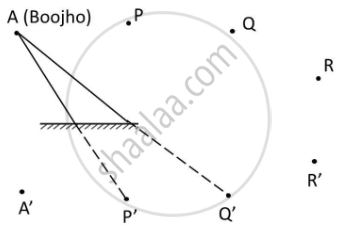Advertisements
Advertisements
Question
Boojho stands at A just on the side of a plane mirror as shown in figure. Can he see himself in the mirror? Also can he see the image of objects situated at P, Q and R?

Solution
A plane mirror forms a virtual image behind the mirror. The image is as far behind the mirror as the object is in front of it. A cannot see his image because the length of the mirror is too short on his side. However, he can see the objects placed at points P and Q but cannot see the objects placed at point R (as shown in the given figure).

APPEARS IN
RELATED QUESTIONS
Describe an activity to show that the incident ray, the reflected ray and the normal at the point of incidence lie in the same plane.
A person 1 m in front of a plane mirror seems to be ______ m away from his image.
What is the angle of incidence of a ray if the reflected ray is at an angle of 90° to the incident ray?
A student does the experiment on tracing the path of a ray of light passing through a rectangular glass slab for different angles of incidence. He can get a correct measure of the angle of incidence and the angle of emergence by following the labelling indicated in figure.
Look at the figure. Can the image of the child in it be obtained on a screen?

The incident angle of a ray of light is 30°. The angle between the incident ray and the reflected ray is ______.
Why do we need a shiny surface for reflection?
If all objects around us were to reflect light in a regular way, what problem might we face?
If the angle of incidence i = 0, the angle of reflection r = ______.
